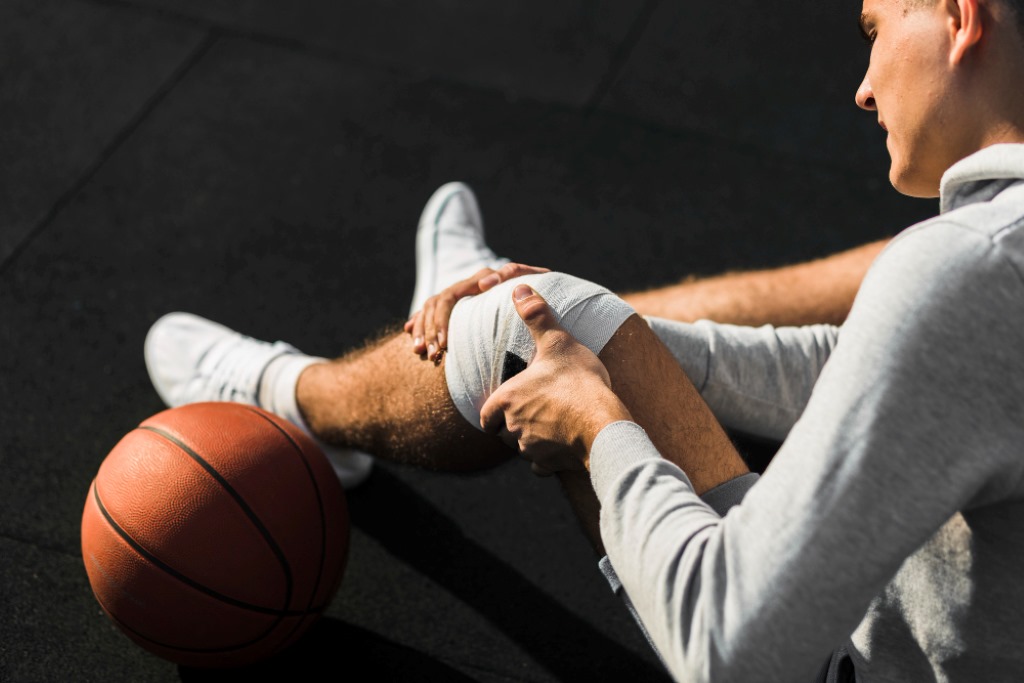Engaging in sports offers benefits, including staying active socializing, and experiencing the excitement of competition. However, it is crucial to acknowledge the risks of sports-related injuries. These injuries range from sprains to severe fractures, affecting athletes of all ages and skill levels.
In this article, we will delve into some encountered sports injuries and their causes, while emphasizing the importance of injury prevention. Additionally, we will touch upon a discussed yet significant topic: injuries in sports.
Types Of Common Sports Injuries
Here are some common injuries, players can face while participating in some sports:
Sprains and Strains
Among the prevalent sports injuries are sprains and strains. A sprain occurs when a ligament is stretched or torn, whereas a strain refers to muscle or tendon tears.
These injuries often arise from movements, overuse of muscles or tendons or inadequate warm up routines. To minimize the risk of sprains and strains, athletes should prioritize up exercises and stretching to enhance flexibility.
Fractures

Fractures occur when bones break due, to high impact collisions, falls or repetitive stress on bones.
To help reduce the risk of fractures athletes should consider wearing gear like helmets, mouth guards and pads. It’s also important for them to learn techniques to minimize the likelihood of falls and collisions.
Concussions
When it comes to concussions, which’re brain injuries resulting from head impacts, they are especially prevalent, in contact sports such as football and rugby.
Athletes participating in these sports should prioritize wearing helmets and employing tackling techniques. Recognizing the signs of a concussion and seeking attention is crucial for effectively managing these types of injuries.
Knee Injuries
Knee injuries, including tears in the cruciate ligament (ACL) or meniscus injuries, are often seen among athletes who engage in sports that require changes in direction like soccer and basketball. To lower the risk of knee injuries, it’s beneficial for athletes to focus on conditioning, strength training and refining their techniques.
Tooth Injuries
While less frequently discussed, tooth injuries can also be a concern when it comes to sports related accidents. Athletes may experience trauma during activities. Tooth injuries can be extremely painful and potentially lead to tooth loss. In such cases, emergency dental care is essential to assess and treat the injury promptly.
To avoid these issues, athletes engaged in contact sports should consider wearing custom-fitted mouth guards. Mouth guards act as barriers by absorbing impact forces and significantly reducing the risk of injuries. They are a piece of equipment that helps athletes safeguard their health while enjoying their favorite sports.

Understanding the nature of tooth injuries, implementing preventive measures, and having a well-coordinated emergency response plan are essential elements in navigating common sports-related dental traumas. Timely intervention and professional dental care can significantly improve outcomes and preserve the long-term oral health of athletes.
Overuse Injuries
Overuse injuries such as stress fractures, tendinitis and shin splints occur due to motion and excessive training without rest periods. Athletes can prevent overuse injuries by following training plans that incorporate designated rest days while being attentive to their bodies signals.
Ankle Injuries
Ankle sprains and fractures are commonly observed in sports involving running and jumping. To prevent injuries from occurring, it is advisable for athletes to wear properly fitted athletic shoes along, with ankle braces if necessary.
Additionally, performing exercises specifically aimed at strengthening the ankle joint can contribute significantly towards injury prevention.
Groin Injuries
Injuries, to the groin area, are commonly observed in sports that involve changes in direction, such as soccer and hockey. It’s important to warm up and perform targeted stretches for the groin muscles to lower the chances of experiencing these injuries.
Shoulder Injuries
Shoulder injuries are often seen in athletes participating in sports like baseball, tennis and swimming. To maintain shoulder stability and prevent overuse injuries, it is crucial to focus on using technique and engaging in conditioning exercises.
Hamstring Injuries
Hamstring strains frequently occur in sports that require sprinting and jumping. To minimize the risk of injuries, it is advisable to incorporate stretching and strengthening exercises specific to the hamstrings.

Preventing Sports Injuries
The prevention of sports related injuries should always be a priority for athletes, at all levels of skill and experience.
Here are some general tips to help you avoid sports injuries:
1. Stay in Shape: It’s important to maintain fitness and condition yourself specifically for your sport. Working with a trainer or coach can help you develop a training plan.
2. Warm Up and Stretch: Always start your sports activity by warming up and doing stretches. This prepares your muscles and joints, for the demands of the sport.
3. Master Techniques and Skills: Learning and practicing technique and skills can greatly reduce the risk of injury. Coaches can offer guidance in this area.
4. Use Safety Gear: Make sure to wear safety gear for your sport, such as helmets, mouth guards, pads or any other protective equipment that is recommended. These items can make a difference in injury prevention.
5. Rest and Recover: Allow your body time to rest and recover between activities. Overtraining can lead to overuse injuries, so it’s crucial to find the balance.
6. Listen to Your Body: Pay attention to any discomfort or pain you might experience during activity. Ignoring signs of injury could potentially lead to serious problems down the line.
7. Maintain Nutrition and Hydration: Ensuring that you have a diet along with staying properly hydrated is crucial for maintaining strength and resilience in your body.
Conclusion
While sports injuries are common when engaging in activities, many of them can be. Minimized through proactive measures. Athletes should prioritize their safety by focusing on conditioning, technique mastery using safety gear as recommended allowing rest time, between activities listening to their bodies for warning signs of injury as well as maintaining good nutrition and hydration habits. By implementing these safety measures, athletes can still participate in their sports while minimizing the chances of getting hurt and promoting a healthy athletic journey.



